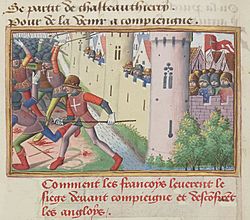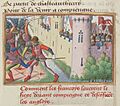Siege of Compiègne facts for kids
Quick facts for kids Siege of Compiègne |
|||||||
|---|---|---|---|---|---|---|---|
| Part of the Hundred Years' War (1415–53 phase) | |||||||
 Siege of Compiègne by Martial d'Auvergne |
|||||||
|
|||||||
| Belligerents | |||||||
| Commanders and leaders | |||||||
| Strength | |||||||
| Unknown | Unknown | ||||||
| Casualties and losses | |||||||
| More than the English, Joan of Arc captured | Less than the French | ||||||
The Siege of Compiègne in 1430 was a big event during the Hundred Years' War. It happened when Duke Philip III of Burgundy tried to take over the town of Compiègne. The town had decided to support Charles VII of France instead of Philip, even though a treaty said it should switch sides.
This siege is most famous because Joan of Arc was captured here. She was with a French group fighting outside the town on May 23, 1430, when Burgundian soldiers took her. Even though the siege itself was not the biggest battle and the Burgundians lost, Joan of Arc's capture was a very important moment in the war.
Contents
Why Did the Siege Happen?
The Hundred Years' War and Alliances
During this time, the Hundred Years' War was still going on. Philip the Good, the Duke of Burgundy, was a powerful leader. He was allied with England. The English were led by John, Duke of Bedford, who was acting as regent for the young King Henry VI of England.
England and Burgundy had taken control of most of northern France. But in 1429, the French army, led by Joan of Arc and Duke John II of Alençon, started winning battles. They had some amazing victories.
Compiègne's Choice
The French defeated the English at the Battle of Patay in June 1429. After this, they marched to Rheims to crown King Charles VII of France. Many towns along their way surrendered peacefully.
Compiègne is located north of Paris. It was not directly on the path to Rheims. However, after Charles VII was crowned, Compiègne and other cities decided to support him. Before this, Compiègne had been under Burgundian control.
What Happened During the Siege?
Getting Ready for Battle
In March 1430, the French court found out that Duke Philip the Good of Burgundy planned to attack Compiègne. The Count of Clermont sent a message to the city. He said Compiègne belonged to Burgundy because of an old treaty. He demanded that the city surrender.
But the people of Compiègne strongly disagreed. The French commander in the city, Guillaume de Flavy, got the town ready to defend itself.
The Armies Gather
Count John of Luxembourg led the first group of Burgundian soldiers. They left for Compiègne on April 4. Duke Philip the Good left from Péronne on April 22.
Meanwhile, the Duke of Bedford was waiting in Calais. He was waiting for the young English King, Henry VI of England, who was only nine years old. King Henry had just been crowned King of England.
Joan of Arc's Arrival
Philip the Good wanted to take back control of cities along the Oise River. This was important because it would help protect Île-de-France and Paris, which were controlled by England and Burgundy. King Charles VII of France had hoped for a peace treaty with Burgundy. But by May 6, he realized that Burgundy's promises were not real.
Joan of Arc had seen the danger before the king did. She started meeting with French commanders nearby. She wanted to convince them to help Compiègne. By April, she had gathered about 300 to 400 volunteers. These included commanders like Florent d'Illiers and an Italian soldier named Bartolomeo Baretta. Joan of Arc left for Compiègne, possibly without the king's full knowledge. She arrived in the city on May 14.
The Fight Begins
A few small battles happened in the days that followed. On May 16, Captain Louis de Flavy had to leave Choisy-au-Bac because of heavy cannon fire. He found safety in Compiègne.
On May 18, Joan of Arc's group tried to surprise the Burgundians at Soissons. Her group now included Regnault of Chartres and the Count of Vendôme. But the people of Soissons would not let them in. The next day, Soissons declared its support for Burgundy.
Joan of Arc's Capture
On the morning of May 23, the defenders of Compiègne attacked the Burgundians at Margny. They attacked an outpost that was separated from the main Burgundian army. Count John of Luxembourg saw the fight by chance. He quickly called for more soldiers.
The new Burgundian soldiers outnumbered the French attackers. The French commanders ordered a retreat back to Compiègne. Joan of Arc disagreed. She wanted to keep fighting. But the commanders refused and ordered a small group to protect the main force as it pulled back. Joan of Arc chose to stay with this rearguard, holding her banner high.
What happened next is still debated by historians. The city gate closed before the rearguard could get back inside. Some say this was a smart move to stop the Burgundians from entering the city. Others say it was a betrayal by Guillaume de Flavy, the city's governor.
The French rearguard, including Joan of Arc, was now stuck outside. They had no way to escape. Burgundian soldiers quickly surrounded them. They shouted at Joan of Arc to surrender because they wanted to capture such a famous person. She refused at first. Finally, a Burgundian crossbowman pulled her from her horse. She fell to the ground.
She then surrendered to Lionel, Bastard of Vendôme. He was a soldier working for the Count of Ligny.
Some people blamed Guillaume de Flavy for raising the drawbridge too soon. Even though Compiègne successfully defended itself months later, the controversy around Joan of Arc's capture hurt de Flavy's career.
Images for kids


